The Magpie Line
By Ted Wilush
Reprinted from "Crown Jewels of the Wire", October 2006, page 23
Story of Insulators, Mines, Railroads and a Small Town in Northern Ontario.
In the fall of 1897, two prospectors, Ben Boyer and Jim Sayers made the trip
from Sault Ste. Marie Ontario to the small gold town of Wawa in the Michipicoten
region of Algoma, on the shore of Lake Superior, in hopes of striking it rich.
While prospecting to the north of the tiny settlement of Wawa, they came upon
two small lakes north of Wawa Lake that they named after each other. In Boyer
Lake, they saw a reddish tinge. It turned out the iron tinge was emanating from
the richest iron ore deposit in the country.

Boyer and Sayers sent a piece of ore from the site to an American
entrepreneur Francis Hector Clergue who was exploring the industrial potential
of Sault Ste Marie (150 miles south of Wawa by rail). Boyer and Sayers wanted
$500 for their claims, but Clergue decided fifty.
In less then a year, Clergue and his Investors Lake Superior Power Corp. had
begun work at the new mine. (Named Helen after one of Clergue's sisters.)
Development including striping the area of moss trees and earth, building a
crusher, bunkhouse and other mine buildings. While the mine was being carved out
of Boyer Lake, Clergue's Algoma Empire began to take shape. A steel plant was
constructed on the shores of the St. Mary's River in Sault Ste. Marie to handle
the ore from the Helen, and a harbour was built in Michipicoten Bay to transport
the ore to the plant. The steel mill was incorporated Algoma Steel.

The Helen mine, one of two on the branch that connected to Michipicoten
Harbour, was the largest iron ore producer in Canada, and operated from July
1900 to 1918, and then closed when the high quality hematite ore (53% iron
content) was mined out. The Magpie mine, which opened in 1909, was located 12
miles from Wawa and was connected to the ACR via a 7-mile spur between Helen and
Michipicoten Harbour. The Magpie's siderite ore was mixed with the high sulphur
ore from the Helen Mine in the roasting plant at the Magpie. The treated ore was
then shipped by train to the harbour and loaded on to ships headed for Algoma Steel. The Magpie survived a forest
fire in 1914, but by 1921 the
failing ore reserves. and unpredictable markets had shut down the mine, The
7-mile spur was not removed until 1925. Also in 1909, a generating station was
built at Steephill Falls on the. Magpie River to supply power to the Magpie
Mine. It continued to supply power until 1924 when it was abandoned and its
pole lines left to rot.
POLE TYPES OF THE STEEPHILL
POWER LINE
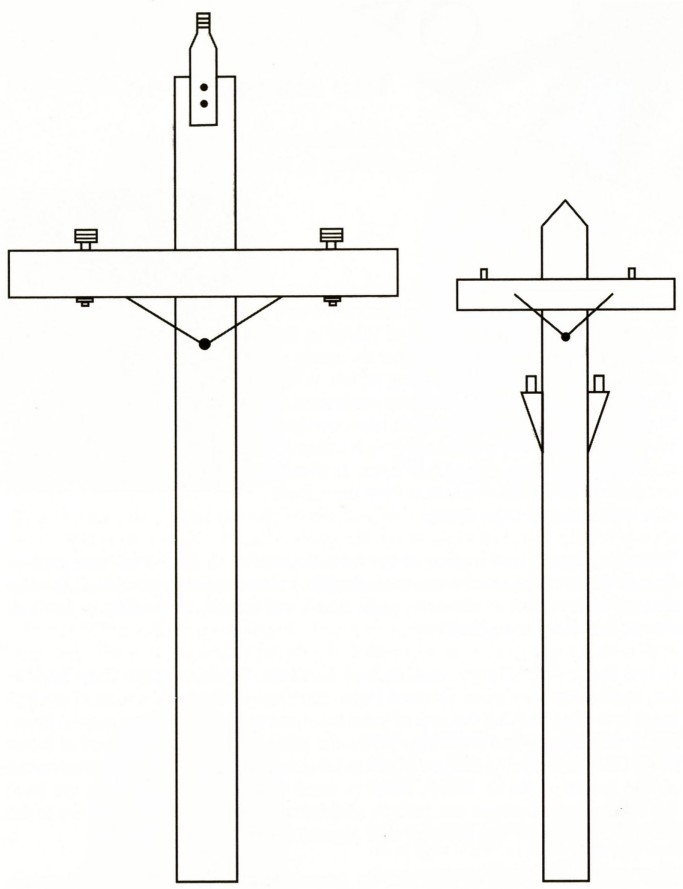
|
Power Line --
Generating Station
to Helen and the other way
to Magpie Circa
1913 |
|
Telegraph Line --
Links numerous area
mines to Wawa |
In 1937 mining resumed at the Helen when new sintering (removing waste from
the ore) techniques were developed for the remaining millions of tons of
siderite ore. A new sintering plant was constructed on the rail line from Helen
to Michipicoten Harbour, just outside Wawa. At Michipicoten Harbour, a new
loading dock was built to load the lake freighters for Algoma Steel and a coal
dock to receive fuel for the machinery at Wawa. The ghost town of Wawa sprang
back to life when the mine reopened. Wawa's remaining structures that survived
the forest fire were repaired and new ones built when the miners arrived to take up lodging. Throughout the
war years, the town was modernized and the sintering plant enlarged. During this
time, Wawa was the only iron supplier in Canada.
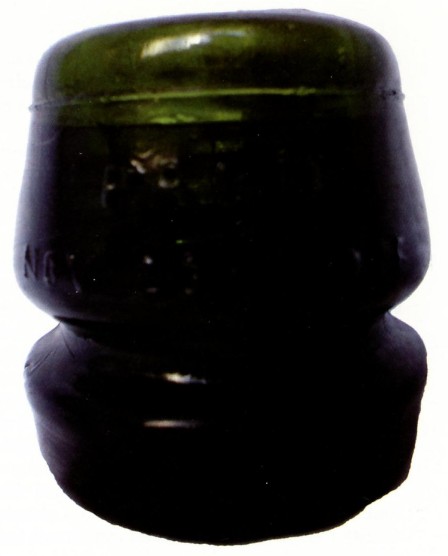
CD 187
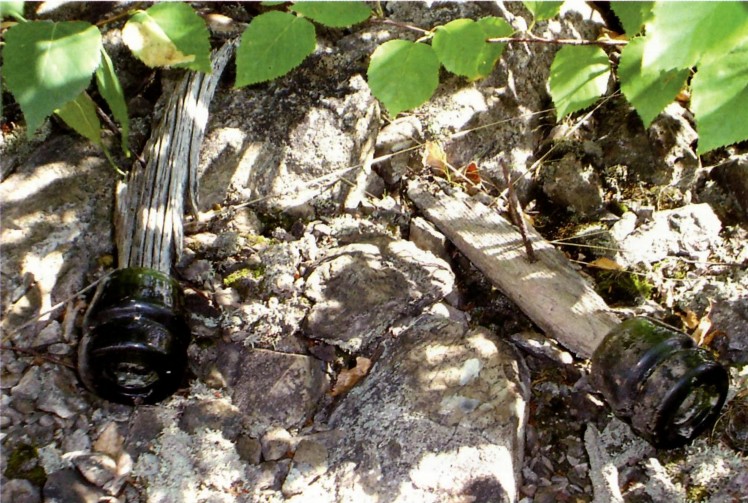
The Helen continued to expand with the addition of the Sir James (1957) and
Victoria Pits at the end of Wawa Lake. Spur lines were added to connect these
mines to the sinter plant. Both mines ceased production in 1967. By this time,
the sinter plant was greatly enlarged, now almost 5 times the size compared when
it was constructed in 1937. Unfortunately, the high sulphur content exhaust from
the sinter plant killed all vegetation for hundreds of square miles behind the
Helen Mine. The sulphur in the ground deposited from the exhaust made the area
highly susceptible to forest fires. One finally occurred and burned off most
traces of any vegetation. The area is still a no fire zone. The mine and now
good sized town of Wawa prospered until 1998, when with Algoma Steel facing
financial difficulties, decided to shut down the Helen Mine. Although the mine
still had much more iron to give, it was considered too costly to remove. The
last ton of ore from Helen Mountain was dumped on in May of 1998. The rail line
from Helen to the sinter plant to the harbour was removed, along with the spur
to the former Sir James Pit.
The sinter plant had its fittings auctioned off and was dismantled. The mine
equipment suffered the same fate. Wawa continues to recuperate from the loss of
its major employer. The town now thrives on tourism of its beautiful scenery and
wild life.
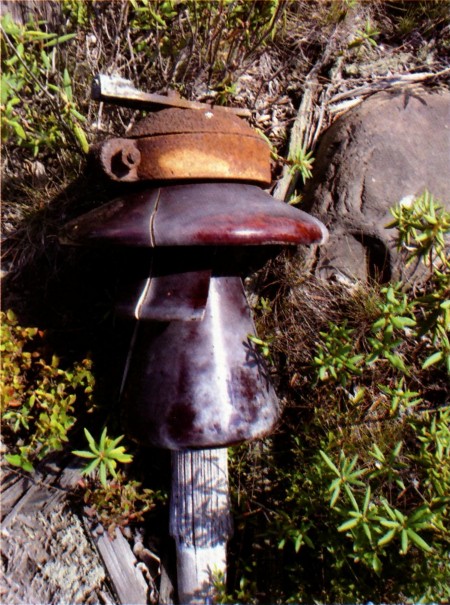
Now, with all the background out of the way, my insulator hunting story
begins. My family has been going up to Wawa every summer to visit my
grandparents for as far back as I can remember. In the summer of 2004, my
grandfather and I took a trip out to the sinter plant fume kill or more commonly
called Steephill (Same name as the power station). The fume kill used to be a
totally barren desert. Even some Wild West movies were shot there. Since the
mine closed however, the area has begun to show signs of life. Small birch and spruce shrubs now litter the
still rather empty landscape. People come from
miles to visit this area for one major reason. Blueberries. The whole place is
carpeted with blueberry bushes producing millions of blueberries almost to grape size, and with a perfect sweet taste.
My grandfather had remembered from when he worked on the Magpie spur line, a
large power line that ran from the Steephill generating station to the Magpie
and Helen Mines. We soon located the circa 1909 pole line from the generating
station. We followed the little piles of broken porcelain insulators and metal
(All the wooden poles had long since been almost evaporated by the dry heat). We
finally reached the site were a substation had stood. It appeared that the whole
thing had been blown-up using dynamite when the Magpie and first Helen mine
failed. The substation was equipped with Victor 3 part multiparts in some nice
glazes and some ancient suspension discs. (Most destroyed or damaged though, I
did manage to get a specimen multipart and suspension disc.) In the same
vicinity, we found a tiny two-insulator telegraph line that ran from Wawa to the
Josephine Mine. Most of the insulators from this line were gone, and there were
almost no shards. We did however manage to find some heavily damaged CD 102 bar
/ bar ponies and some Brookfield 160s and 145s. We continued to follow the power
line towards Magpie, searching for a whole insulator. We finally came upon the
nearest to a whole specimen to date. It consisted of a large porcelain cable
insulator, which I believe to be M-2120S (Marked Victor R=4) mounted on a steel
pin with wood insert along with a porcelain pin base. They are found in mottled
mahogany to almost black glaze.
The porcelain pieces would have been the main power insulators to the Magpie
Mine running from the dam, while the 187's were likely used for telegraph
communications [Line diagram page 24] But the best finds were yet to come, a few
poles down I spotted something glimmer beside a newly sprouted birch tree. I
lifted it out of the dust and realized it was a CD 187 Pat. Other. The colour
was a nice olive black glass. We continued down the line finding 2 more 187's on
their original and weathered wood side pins (one in olive black glass and the
other in emerald green), along with a few shards.
Over the course of the summer, I continued to explore this line, following it
for nearly 6 miles over rough and rocky terrain and almost directly to the
former site of the Magpie Mine. I was able to pick up a number of 187s and pin
bases but the fragile M-2120S were always smashed. In my opinion, the compact
design and solidness of the 187s and pin bases was the deciding factor in their
survival.
Usually, after I had finished hunting the line for the day, I would walk back
to the truck on the abandoned Magpie spur. The poles along the track had long
since been chopped down, but mostly contained clear and straw CD 155 and 154
Dominion-42s as well as Hemingray CD 129s. It occurred to me that perhaps I
should take a look at a few poles to see if I could find anything of interest,
considering my past experiences on the ACR had led me to some interesting
specimens.
The first pole I came to revealed a grisly sight. Two dark orange amber 154
Dominion-42's melted and broken beside a pole stump. I noted that they were
victims of a long ago campfire by the line crew probably in the 50's when the
line was taken out. I cursed and wondered why they didn't burn the straw one
that I found sitting near to the fire sight instead. After digging around to be
sure I did not miss anything, I continued down the line. Fortunately, luck was
with me and I was able to my jubilation pick up a complete orange amber 42 from
the crusty soil. It had a couple wire groove chips, but it was incredible to actually find one in the wild.
(See Insulator of the month - inside front cover. )
August update:
This summer I spent a few more hours working this line to see
what I could come up with. I revisited the old substation and while scratching
around, I caught a piece of wire with my rake and pulled out another olive
blackglass CD 187. The substation remains are some what spread out and are thick
with porcelain shards, mostly consisting of large Thomas muItiparts,
Locke/Victor glaze welds and suspension discs. Many metal and wire components
are also abundant such as wire and large switches.
My next trip out, I continued to follow the line and was able to track down a
number of other poles. On the first pole I dug out a few 187 shards, and
destroyed porcelain specimens, along with a couple mint pin bases. The next few
poles yielded little, but near the end of the hunt I located a second 187
beneath a sapling birch tree much to my delight. This line has yielded many nice
insulators; and with many miles in multiple directions yet to be hunted, I
expect it will continue to do so.
Bibliography
Rowe (Morrison), Johanna. Heart of a Mountain Soul
of a Town.
Canada:Friesens,1999
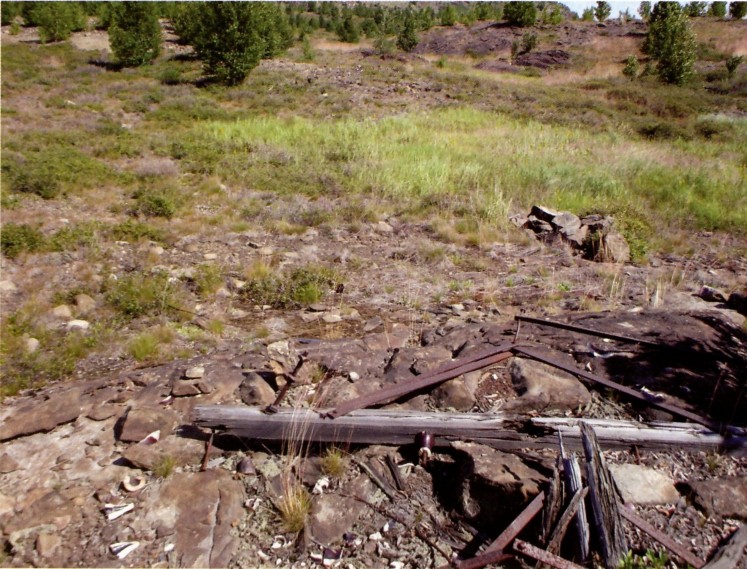
Evidence of the Steephill Substation and pole line.
| 